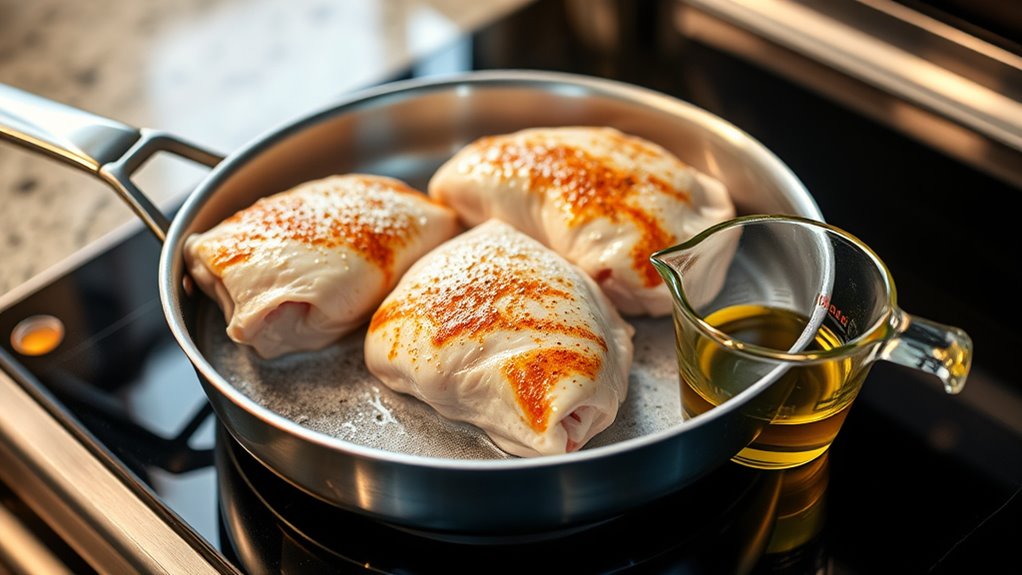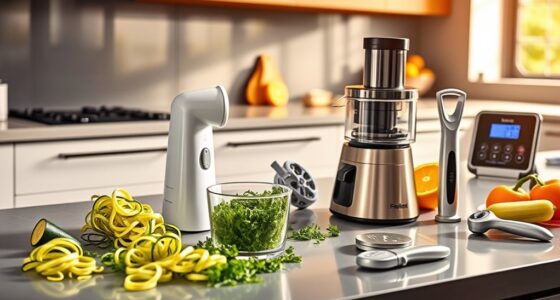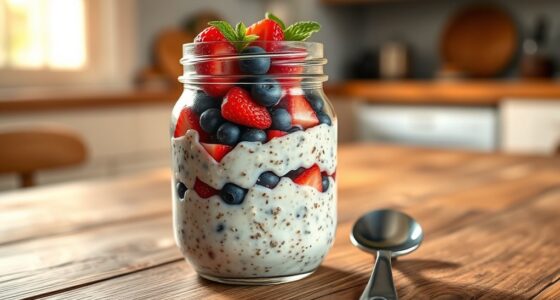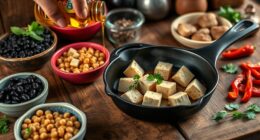To cook straight from the freezer, skip thawing and toss frozen vegetables directly into your pan over medium-high heat. Add a splash of oil, broth, or water, and cover to trap heat and steam the vegetables until tender. Stir frequently to evaporate excess moisture and prevent sogginess. Season well with herbs or spices for flavor. For more tips on perfect no-thaw cooking, keep exploring the techniques that streamline your meals.
Key Takeaways
- Cook frozen vegetables over medium-high heat to evaporate excess moisture and prevent sogginess.
- Toss frozen items directly into dishes like stir-fries or soups without thawing.
- Cover the pan to trap heat, accelerate cooking, and tenderize vegetables.
- Add oil, broth, herbs, or spices to enhance flavor during cooking.
- Adjust the heat as needed to manage water release and ensure even, flavorful results.

No-thaw cooking is a convenient technique that allows you to prepare meals directly from frozen without the need to defrost beforehand. This method saves time and streamlines your cooking process, especially when you’re juggling a busy schedule. One of the most versatile frozen items you can cook straight from the freezer is frozen vegetables. They’re pre-washed, pre-cut, and flash-frozen at peak freshness, making them perfect for quick meals. Using frozen vegetables in no-thaw cooking means you can toss them directly into stir-fries, soups, or sautés without waiting for them to thaw. This not only preserves their nutrients but also keeps your prep work minimal. When incorporating frozen vegetables into your recipes, keep in mind that they release some water as they cook, so it’s best to cook them over medium-high heat to evaporate excess moisture and avoid sogginess. Keeping your frozen vegetables organized in your freezer storage techniques can help streamline your meal prep process and reduce waste.
Meal prep tips become especially valuable when you’re cooking straight from the freezer. Always keep a variety of frozen vegetables on hand, such as broccoli florets, peas, spinach, or mixed vegetables, to diversify your meals. To save even more time, portion your frozen vegetables into smaller servings before freezing, so you can grab just what you need for each meal. When preparing these vegetables, consider adding a splash of oil or broth to boost flavor and help them cook evenly. Covering the pan during cooking helps trap heat and steam, speeding up the cooking process and ensuring vegetables are tender. Additionally, season your vegetables well—garlic, herbs, or spices can elevate the flavor without extra effort or additional ingredients.
Frequently Asked Questions
Can All Foods Be Cooked Directly From Frozen Safely?
Not all foods can be cooked directly from frozen safely, especially delicate items like seafood and some vegetables. You should consider deforestation concerns when choosing frozen foods, opting for sustainable options. Cooking from frozen can help preserve flavor and texture, but always follow specific guidelines to prevent food safety risks. For best results, check the manufacturer’s instructions and use proper cooking methods to guarantee safety and quality.
How Does No-Thaw Cooking Affect Nutrient Content?
Cooking straight from the freezer is like catching a snowflake in your hand — delicate and fleeting. It slightly impacts nutrient retention and vitamin preservation, but not enough to ruin your meal. While some vitamins may degrade a bit, overall, no-thaw cooking helps preserve most nutrients because it minimizes exposure to heat and air. So, you still get a nutritious meal, even when you skip thawing.
Are There Specific Recipes Best Suited for No-Thaw Methods?
You’ll find that some recipes are perfect for no-thaw methods, especially frozen dessert recipes and dishes using uncooked frozen vegetables. For instance, you can bake a frozen pie or cook frozen stir-fry vegetables directly on the stove. These methods save time and preserve freshness. Just follow specific instructions for each recipe, adjusting cooking times as needed, and enjoy quick, delicious meals without thawing first.
How Do Cooking Times Differ When Using No-Thaw Techniques?
Did you know that cooking times can increase by up to 50% when using no-thaw techniques? When you skip thawing, you need to account for thawing safety and verify your cooking appliance is compatible with frozen foods. Typically, you’ll allow extra minutes for thorough cooking. Always check internal temperatures to ensure safety, especially since frozen foods take longer to reach the right temperature for safe consumption.
Is No-Thaw Cooking Safe for All Types of Cookware?
You should check your cookware’s compatibility before no-thaw cooking, as not all materials handle freezer damage or rapid temperature changes well. Use oven-safe, sturdy cookware like cast iron or glass; avoid thin plastic or non-stick pans that may warp or crack. Properly selected cookware ensures safety and prevents damage, so always verify it can withstand direct freezer-to-cooking shifts for safe, effective no-thaw meals.
Conclusion
Think of no-thaw cooking as steering a ship straight through stormy waters—you’re maneuvering the challenge head-on without hesitation. With a little confidence and the right techniques, you can transform frozen obstacles into delicious meals in no time. Embrace the adventure of cooking straight from the freezer, and soon you’ll find it’s as natural as sailing smooth seas. So set your course, trust your skills, and enjoy the journey of effortless, frozen-to-finished meals.









